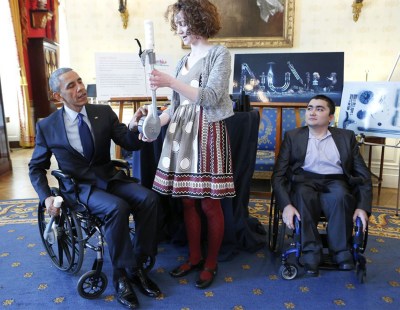Kate Reed is an artist. Kate Reed also builds hand-driven wheelchair accessories that work with any wheelchair. Wait, what? These things don’t have to be separate skills. We’re living in the age of artisanal creation and Kate is a perfect example that you need to embody all skills. She’s an artist who follows a creative idea from inception through to implementation. Check out her talk on the Creative Process in Action from the Hackaday SuperConference, then jump past the break for some more details on what she’s been building and how she build her diverse set of skills.
Kate’s accomplishments stand on their own. She worked with her friend, Nathaniel Tong, to develop a hand drive wheelchair attachment. Their creation improves the lives of those in wheelchairs by adding a lever which maneuvers the chair in a rowing motion. This uses strong muscle groups, is easier on the user’s back, and (something we’ve never thought of before) it helps keep the user’s hands clean compared to pushing at the wheels which themselves are touching the ground. The project was recognized as a Best Product finalist during the 2015 Hackaday Prize.

You should be surprised to learn that Kate is a High School student. But her education is taking a much different approach to traditional high school learning. She attends the NuVu Studio, an innovation school for middle and high school students in Cambridge, Massachusetts. The focus is to study the creative process from start to finish. The curriculum involves conceiving, developing, and building things. To us it looks like a technique that turns on its head the stereotype that students having no experience coming out of school, and we like it!
We enjoyed Kate’s comment that “Creativity takes practice”. The current design of Hand Drive is the sixth prototype. They have been getting better with each rendition, but even the current one broke just as she was demonstrating it to President Obama (after a full day of senators and press giving it a stress test). She rolls with the punches and embraces failure as vehicle for future improvements. We need generations of people who approach life with this creative spirit and we’re thankful that Kate is helping pass on those lessons with her Open Designs and with talks like this one.
















Inspirational. Awesome story.
She should look deeper. Wheelchairs are terribly designed, desperately over priced and over massively pweight. (An engineer in a wheelchair)
Indeed, engineers have built modern chairs that ballooned costs. Someone should do some parametric OpenSCAD files for water-jet cut versions that use off-the-shelf 80/20 extrusions. The thing could be customized for the individual preferences, use standard bicycle parts, and have low local fab house shipping costs.
Maybe post a gofundme link to get your design cut out of aluminium or carbon fibre honeycomb.
One could also build a large hex-leg walker exoskeleton, but it would likely look similar to Doctor Octopus. I am unsure how the public would respond to a giant 6′ tall cybernetic spider-like-man, but it sounds like the origin story from a sci-fi dystopian nightmare.
I’ll speculate that a modified miniature Segway style device with a low-power locking-position stand mode, folding support structure mode for sitting down on normal chairs, self-righting squat mode to lower the centre of gravity, and maybe some sort of stair climber mode. One would have to do the folding structure Math on 3 pieces of 80/20, and 3 aluminium linear actuators. Perhaps submitting a revised design proposal and hands-free control interface to the WalkCar guys may yield some options http://www.cocoamotors.com/ .
No US based medical company would likely take on the liability of a possibly unstable system, but I suspect the only technical limitation is the traversable area coverage would be similar to a chair. One could wear a helmet during testing, and buy a more stylish http://www.hovding.com/ for regular business use.
=)
Some parts should be expensive (high value), those parts that one could reasonably expect to last as long as the life time of the user should be of the most ideal materials available, even if they are expensive. But the users should be able to fund the parts over their lifetime, not up-front. The more consumable parts should be selected from cheaper and renewable materials. Those modules that are more likely to become obsolescent should also be treated as proportionally consumable. Obviously this requires a very modular and serviceable design approach.
I suggested bike parts for several reasons:
1. Local availability of parts, and bike mechanics
2. A wide range of part options with a projected economic impact lower than a $200 bike
3. Interchangeable parts for structural changes over the lifetime of different users
I did a quick sim for the mini Segway board with limbs bond to a primitive robot leg armature on the platform.
It does seem relatively stable under several conditions:
1. If the load distribution remains centre enough to maintain drive traction, than it can be modelled as a simple inverted pendulum problem
2. There would be limits to how much weight can be shifted outside the natural centre of mass, would depend on users height and drive motor output limits (4 Mecanum wheels may be needed )
3. Users would need to expect falls will eventually occur when system failures occur from wear. Any regular transition to an unstable surface (like grass or sand) may result in drive slippage. Thus, if someone has any other health issues it could certainly cause additional impact related injuries.
From a legal perspective, the expectation of product safety by the public is the foundation of manufacturer liability. So if the device is sold like any other bike/sports-equipment for everyone’s use its fine, but the instant one intends its use as a “medical device” you have a serious barrier to selling them cheaply or getting manufacturer insurance coverage.
I’ll have to ask legal at work if people could hypothetically give it a goofy name like “LegWay” and sell it as equipment for a yet to be invented sport of some kind.
=)
Something like the Leveraged Freedom wheelchair? http://www.gogrit.us/lfc/
I agree, they were designed in an era when “things” were expensive to make and so they contain a lot of redundant assumptions.
In a new design, assuming human and not electric power (but a hybrid would be smartest), the user’s energy could go into a flywheel (that could also lower the centre of gravity) then that power transferred to the wheels as required. The flywheel would absorb energy to slow down the chair, thereby making it available again when they moved again. With the right mechanics reversing would work just as well. The drive could be a bar that can move out of the way (multiple options there) the bar has the speed, direction and breaking controls on it. The hand grip could by a “dead man” type so if you let go all of your velocity gets dumped into the flywheel.
Wheel chairs should be like top-of-the-line bikes, but engineered to meet the needs and capabilities of the individual user. So a typology of users must be created before a set of re-combinable solutions can be designed to cover everyone’s requirements.
I guess that would be more of a revolution that a hack, unless inducing paradigm shifts is a case of “hacking reality”, which I think it is.
If you want things cheaper, you have to get rid of the lawyers.
http://www.aliexpress.com/item/Lightweight-folding-electric-wheelchair-scooter/32392993165.html?spm=2114.01020208.3.162.me1VTY&ws_ab_test=searchweb201556_1,searchweb201644_3_79_78_77_82_80_62,searchweb201560_5
There can’t really be too much experimentation when the cost of being wrong is so high.
I’m having a difficult time in seeing how the link to product is relevant to the comment. I regards to lawyers, would you really deny yourself access to one if it where you or someone you care about are the one paying the high cost of being wrong? Because of a medical diagnosis and resulting wrong direction I’m disabled and struggle financially. Every month ends with my second guessing my decision not to pursue a malpractice law suit.. There where many factors considered in my decision. But ignorant attitudes and beliefs about lawsuits in the USA was at the top of the list. Perhaps if society in the US was compassionate enough to spread the high cost of being wrong across our society.
IMO, the problem isn’t lawyers, it’s a combination of the attitude towards law and the lack of a national healthcare system and general social safety net.
If someone gets hurt the costs can bankrupt them. If they’re the breadwinner for a family, there’s few options *but* to sue for expenses and lost wages due to disability. Sometimes it’s sue or starve. People talk about Japan being a less litigious society, and it may well be the case that it’s a social norm, but folks there also have functioning social programs to fall back on.
Then you add in attitudes toward liability as a general concept, about how much responsibility a manufacturer has when someone finds a way to hurt themselves with a product. When product warnings in a manual no one reads can shield a company from liability despite it being common knowledge no one reads them (because what the hell else can a company do, make the product scream the warnings?) I feel like there’s a problem with how liability is determined.
Totally agree.
In fact, I believe the lack of healthcare, education funding, and especially pension system is basically “what is wrong with America”.
That and the private army we pretend is ‘our army’
Great talk and an awesome product! Excited to see where this goes!
A interesting maualwheel chair drive. I spent some time dependent on a wheel that because of hemiparisis I couldn’t operate very well, but this appears to be what I needed 21 years ago. Though I still have problems I generally ambulatory now.
Weird though, ive seen these hand cranks on wheel chairs for years.
But ill just be quiet about it, since those are apparently pretty expensive (they are nice alu things tho) and by the looks of this article (the president trying it?!) never reached ‘murica
Very good presentation, but not new unfortunately. Check out the “Wijit Lever-Drive & Braking System”
kate reed I would like to be able to correspond with you regarding the wheelchair lever Very pleased that you have come so far